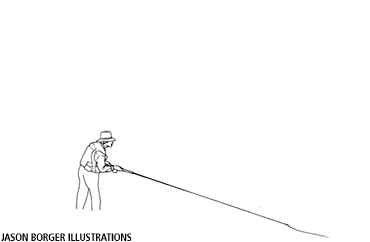|
Double Spey Instruction:
THE DOUBLE SPEY is one of fly fishing's most beautiful methods of presenting a fly. It really comes into its own in flowing water environments where backcast room is at a premium. It allows a long length of line to be quickly moved and then cast forward in one flowing, sweeping act of artistry.
 #1. Begin with the rod tip pointed down the line.
#2. Using controlled arm and body motion, lift the rod tip and then sweep the rod up-current so that part of the line becomes airborn, and the fly "anchors" across and slightly down-current of your position.
#3. Sweep the airborn portion of the line across in front of you and then up and back on your casting arm side. This is the line and rod position for making the Forward Spey delivery.
#4. Before the line falls to the water's surface, make the Forward Spey cast.
#5. The line will air-roll out, pull the anchor, and head to target.
#6. Fish the fly through and prepare to make another Double Spey by getting into casting position once again. Tip:
This tip deals with instruction #2 & #5, placing the anchor or stick (I'll use the term "anchor" here). The anchor is a short section at the front of the fly line (plus the leader and fly) that remains on the water. Try to have as little fly line anchored on the water as possible (typically single digits in terms of length). I also prefer the anchor to be as far out in front of me as is convenient. This is based on many factors, such as current, wind, rod length, and line weight. Correct anchor length and placement for various casting distances will require only a bit of experimentation to discover.
Place the anchor on the outside of an imaginary line drawn from your casting arm to the target. This prevents crossing loops which tangle line and fly. Once the forward cast is made, the line will roll out past the anchor, pull the anchor from the water, and deliver the fly to the target.
Once the anchor is in place and the line is aerialized behind you, you can't waste any time--that's the trick. If the line falls to the water or into the weeds, the cast is in trouble. So, once that line is up and "hanging" in the air, it's time to get going forward.
|

